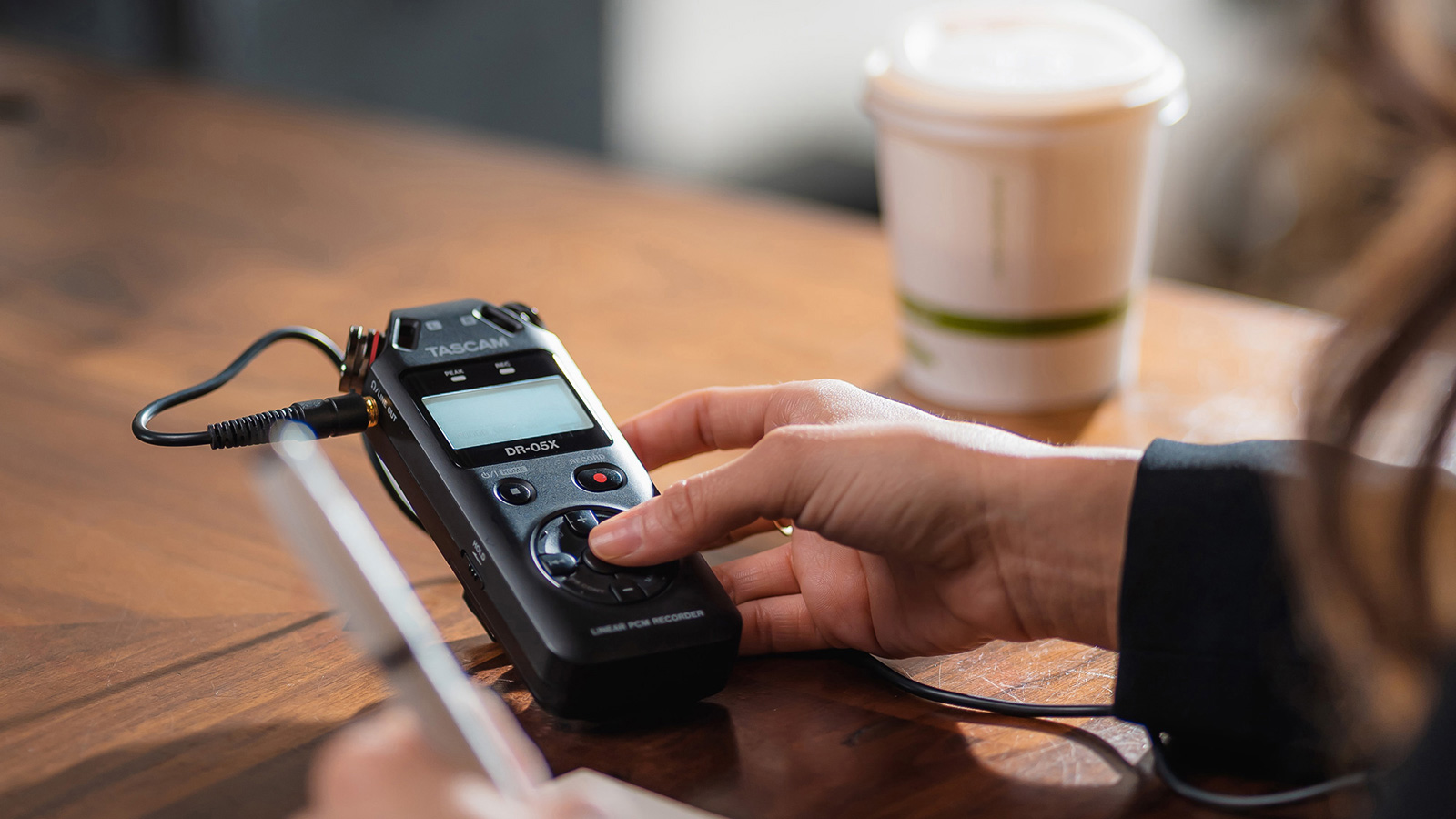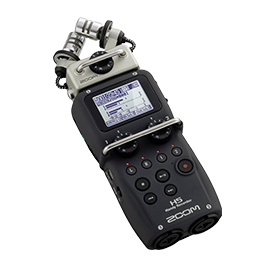A handheld digital recorder can serve so many purposes, from everyday casual recordings to professionals conducting interviews or carrying out field recordings. In this guide, we'll be going over all the information that'll help you decide on a great recorder for whatever your application!
To make everything as easy as possible for you, we’ve broken this guide down into 3 main sections: A quick guide on the key details, a section on the brands to look out for and a final in-depth section that goes into much more detail.
Click the tiles below to navigate to the relevant section!
Uses & Applications
There are a wide range of applications that handheld digital recorders are great for, and different models of recorder will offer a variety of different functions and features.
But why not just use your phone’s mic? The answer is simple. A dedicated recorder will have better microphones, better stereo imaging, and better compression available. This all combines to produce a higher quality recording

Two track - Ambient Recording / Band practice / Field recording
Some very common applications to use a handheld recorder include recording a live music performance (just as a band rehearsal or live show) or field recordings – such as sounds of nature.
A two-track recorder would suit this type of application well, as you’ll be able to capture a stereo sound to give a sense of positioning in your recording.
Four track - Interviews / Conferences
A four-track recorder is a great option for recording things like conferences or interviews, where you might want to clearly capture the speakers with extra dedicated tracks used to capture crowd or background noise separately to give the listener a greater sense of immersion in the recording environment.
Our videos taken at NAMM are a great example of this method. We dedicate one track to backing music, while the mics used for commentary and interviews use 2 of the other tracks. This is done because it’s imperative to have dedicated controls for each track. Likewise, if you’re a reporter conducting an interview, you’re going to want to keep each voice isolated in a different track as different people speak at different volumes and will require different adjustments. This holds true even if you’re using less than 4 tracks.
Portable Interface
Some handheld recorders also function as handy portable audio interfaces. This dual functionality is a bonus for those who want to record to their DAW in a remote setting or on-the-go. It’s also a handy way to add overdubs to a recording.
It’s also likely to be a simpler piece of gear than your typical audio interface, which may be a benefit for those who struggle with tech or just want a quick alternative.
Video capabilities
Some handheld recorders also feature an on-board camera, which could be a crucial feature for some of you. If you’re recording your new song at band practice, you probably don’t need video to accompany the audio. However, if you’re recording a live on-stage performance for example, video footage might be a desirable addition.
Number of Mics
Almost all handheld recorders today feature high-quality stereo mics built in that make setting up a breeze. It’s worth considering how many mics you’ll want depending on your needs and the audio quality you aim to capture. You’re likely to pay more money for more microphones but you will also receive greater freedom and flexibility in your recording process.
Interchangeable Capsules
Different capsules feature different polar patterns, with each suiting different applications more than others. You may want the flexibility to change out your capsule, depending on your project.
If you’re carrying out a nature recording for example, it may be beneficial to have a system in place that allows you to swap out different options.
An omnidirectional capsule could be ideal for capturing soundscapes, whereas a capsule with a directional pattern, such as a cardioid pattern, would capture a specific source like a bird with greater focus.
Build Quality
The build quality of any purchase is of great importance. You can often save money by buying a product made from a cheaper material, and this may be fine if the features available and the quality of recordings suit your needs. However, you may find that a more robust chassis makes a big difference, especially with a product designed to be taken out of the house and used on the go.
It's painful to open your bag to be greeted by the sight of broken gear, and this is of course a risk when buying an item made from cheaper materials such as plastic, instead of metals. Investing in a more robust recorder may cost more money in the short term, but it could mean you save money in the long run as you might avoid buying replacements.
Number of Tracks
The number of tracks you can record is one of the most important criteria to consider when choosing a handheld recorder. It’s crucial to keep all your audio sources balanced and the best way to do this is to isolate them in different tracks so you have total control over each source independently. It might be worth investing in a recorder that features more tracks than you think you need right now, you never know…

Ins & Outs (I/O)
If you need more control and options, many recorders have mic/line inputs and use common XLR or TRS connectors allowing you to plug any microphone or line-level device straight in. These extra inputs mean you can plug instruments or other line-level sources into the line input and record multiple tracks at the same time.
As dedicated audio tools, many handheld recorders feature a line-out to be used with a digital camera. Many cameras’ on-board mic quality is limited, and so they often feature a line-in for a dedicated shotgun mic or handheld recorder. This allows you to combine a higher quality audio recording with the video captured by your camera.
You’ll also want to find out the recorder’s phantom power capabilities. Many recorders can provide optional phantom power to their inputs which opens the possibility of connecting condenser mics (dynamic mics do not require phantom power).
Some recorders even allow you to choose between 24V or 48V phantom power, enabling you to use an even wider range of different microphones.
Can it Function as an Interface?
If you’re looking to record sessions in your DAW while on the go, then a recorder that can also function as an audio interface when connected to your computer might be for you. Some recorders even come with editing software. All you need is your recorder, computer and a connecting cable and you’ve got a portable interface ready to go!
One benefit of using your recorder as an interface is that you can mix your tracks in real time and adjust levels on the fly, absolutely anywhere. If you’re planning on using your handheld recorder as an audio interface regularly, be sure to check out whether the recorder you choose is compatible with your DAW of choice.
Battery Life
All handheld recorders run on battery power and use either disposable or rechargeable batteries and can offer operating times ranging from 2 hours to over 40 hours of nonstop use.
There are a few factors that will impact your battery life, such as the recorder itself, the audio quality you’re recording at, and the battery type. You might want a recorder that also offers power-saving modes, especially if you’re going to be in a remote location with no access to batteries or a plug socket for extended periods of time.
Some handheld recorders can be used with an AC adapter. This is of course very handy when recording indoors and you don’t need to be moving around. Using AC power allows you to record without worrying about battery life – one less thing to ruin your recording session.
What Other Features Can Handheld Recorders Offer?
From built-in effects to app connectivity, there are a wide and impressive variety of options available in different models. What do you need right now, what might you need in the future and what does the technology give you for the money spent?
Depending on how you like to work, you can opt for a hands-on recorder that features tactile buttons to navigate menus and controls, or you can go with a recorder that has a touchscreen for navigation. Some offer a combination.
Smartphone compatibility through dedicated apps or Bluetooth might be something that makes a big difference to you can be a huge benefit when you’re in a situation where physically handling the recorder is inconvenient or unviable. Smartphone control can make the recording experience even more remote and fine-tuned.
Some recorders are geared toward certain professions - such as journalism - and offer features such as slow-motion playback, which can be very helpful when transcribing an interview. Other recorders are targeted towards musicians and offer digital effects such as reverb, filters and even amp modelling.

Recording Formats
Typically, you’ll find yourself recording at 44.1Khz, 24-bit however some recorders can go above this. You may want to use a higher sample rate/bit rate as you’ll be capturing far more detail. It’s worth noting that you can always downsample a recording, resulting in lower quality and a smaller file size, but you can’t upsample a recording.
It’s important to remember that higher-quality formats will take up more space than compressed MP3 files. Check out the Ultimate Guide later for more information on the different formats and the amount of storage space they will take up. You definitely don’t want to run out of memory right in the middle of a recording!
Memory
Internal storage capability is great for those making short recordings or those who regularly back up to their computers. The main advantage of using internal storage is that you don’t have to keep extra SD cards with you when you’re recording. However, if you’re using internal memory and run out of storage space, you won’t be able to keep recording until you back up your recorder and make some space.
External storage options for handheld recorders are small SD memory cards. We’ll cover the different types in more detail in the Ultimate Guide later.
The more space you have available, the more audio you can record. Make sure your storage method of choice will be capable of holding enough data for your general usage.
Zoom
Zoom designs and produces a wide array of recording devices, multi-effects processors, effects pedals, digital mixers, and samplers. Our innovative, cutting-edge technology is trusted world-wide by sound designers, musicians, podcasters, filmmakers, location sound professionals, electronic news gatherers, and pretty much anyone who creates amazing, important things. Their mission is to design, develop and manufacture high-end and easy-to-use creative tools that allow anyone, from amateur to professional, to more freely express their creative ideas in today’s digitally-driven world.
Tascam
Since its birth in 1971, Tascam has supported the people involved in the recording and playback industry around the world. For decades now, Tascam has been one of the leading choices for musicians, engineers and broadcast professionals worldwide by combining industry leading fidelity with legendary reliability. With solutions designed for a wide array of audio applications and catering to today’ s top professionals, Tascam continues to define the sound of modern recording.
Roland
Roland's diverse product range includes electronic musical instruments such as electronic drums, digital pianos, synthesizers, and dance/DJ gear, plus a broad line-up of professional audio/visual and music production equipment. Since their founding in 1972, we have developed a steady stream of world-leading technologies and trendsetting products that have inspired creators and helped define entire musical genres.

Number of Tracks
Most handheld recorders will record in stereo, but if you need more than just stereo, you might want to get a recorder with extra microphone inputs.
Many recorders can record four tracks simultaneously – using two built-in mics and two XLR or TRS connectors. Adding two extra mics allows you to record the main mics along with additional instrument mics or room mics, for example.
Some recorders can even record up to eight tracks simultaneously. These designs often add six XLR or TRS inputs to the standard onboard stereo mics. A recorder with this capability can record bigger live projects – such as your demo or full band practice.

Mic Configurations
There are several different microphone configurations you should know about to help you decide which recorder is best for what you plan to record.
Stereo or Mono
If you’re recording simple audio, such as rough song ideas or interviews to later be transcribed into text, a single-mic mono recorder will likely do the job. A dual-mic recorder capable of stereo imaging might better suit your needs where quality is of greater importance, for example a live performance, due to its ability to present a more accurate representation of the space and positioning of what’s going on.
XY
A lot of recorders have a built-in XY configuration. The XY set-up comprises of two cardioid microphones angled between 90 and 135 degrees positioned at the same point to produce a stereo image. Sound arrives at nearly the same time which reduces potential phase problems.
MS (mid-side)
Another type of configuration is the MS (mid-side) set-up. This includes a cardioid microphone (mid) that faces directly at the source while having a bi-directional microphone (side) that faces left and right.
This gives you a nice blend of focused sound from your mid mic and a wider sound from your side mic, which is a great option if you want to clearly capture a single source but want to also capture the ambience of what’s going on around it on two separate tracks.
AB
The AB set-up is another optional microphone configuration. This type includes two cardioid or omnidirectional microphones, spaced a few inches apart from each other, and panned in left/right.
Stereo Linking
Stereo linking involved linking 2 adjacent mono tracks on a recorder (1/2, 3/4, 5/6 etc.) to be used together as a stereo pair. Once linked, they will be synced and gain set, which means one track will be the master, allowing you to control the gain and general settings on one track and have the changes apply to both tracks in the stereo pair. When recording to a stereo track, a stereo WAV file is created.
Future Proof Your Setup
It’s also important to remember that while you might be sure of your immediate recording needs, this could easily change in the near future.
You might think you’re only ever going to be recording a specific number of people, for example 2 mic inputs for a 2-person podcast. In this instance, a recorder with 2 inputs will do the job. You may however find yourself in a situation where you have a third person on the show, in which case another input for a third mic is going to be necessary. Make sure you invest in a recorder that has enough inputs (and other features) for any potential future projects and won’t leave you looking for a replacement shortly down the road.
As well as physical features and options, it’s also worth considering the quality of recording available. You may only need to record at a standard 24-bit/96kHz, however there might come a time when you require 24-bit/192kHz or even 32-bit/192kHz. Instead of being unable to take on a project which demands higher qualities, you’ll be well prepared for anything if you choose a recorder that can record at a higher resolution.

Recording Formats
Higher-quality lossless recording formats take up far more space than compressed MP3 files.
You can get an incredible amount of recording time available in a small package such as an SD card. However, it’s worth remembering that total available recording time depends on the recording format you choose. Uncompressed CD-quality recordings take up far more space than a compressed MP3, sometimes by nearly a factor of 10!
The table below shows recording duration with various formats using 32GB of storage space as reference.
|
Format |
Recording Time Available |
|
MP3 128K |
555 hours (23 days, 3 hours) |
|
WAV 16-bit/44.1kHz |
50 hours (2 days, 2 hours) |
|
WAV 24-bit/48kHz |
30 hours (1 Day, 6 hours) |
|
WAV 24-bit/96kHz |
15 Hours, 25 Minutes |
|
WAV 24-bit/192kHz |
7 Hours, 42 Minutes |
|
WAV 32-bit/192kHz |
5 Hours, 47 Minutes |
External Memory
Handheld recorders use small SD memory cards for external memory. The three common types of SD cards found in handheld recorders are MicroSD, SDHC and MicroSDHC, and SDXC. The standard MicroSD card is capped at 2GB of storage. SDHC can handle up to 32GB of storage. SDXC cards are usually sold with 128GB capacities but can be purchased with storage space up to 1TB, and of course the price increases with data capacity.
32-bit Float
Audio is encoded into files in a variety of bit depths. In short, the fewer the bits, the less precisely the digital audio can present the analogue sound waves. 32-bit floating point can represent a much greater dynamic range when compared with standard fixed point (16 or 24-bit) files.
The dynamic range that can be represented by a 32-bit (floating point) file is a massive 1528 dB of headroom, which is far beyond what will ever be required to represent sound amplitude.
More Info
Follow the links below to check out all our products and other great guides to help you find what you need! If you have any feedback on this guide, or any further questions you'd like to ask us, get in touch and we'll be happy to help!
Shop All Digital Handheld Recorders Buyer's Guides Homepage Any More Questions? Contact Us




